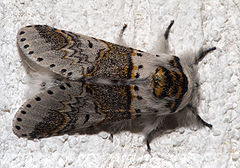- Notodontidae
-
Notodontidae

Furcula furculaClasificación científica Reino: Animalia Filo: Arthropoda Clase: Insecta Orden: Lepidoptera (sin clasif.): Macrolepidoptera Superfamilia: Noctuoidea Familia: Notodontidae
Stephens, 1829Subfamilies Biretinae
Dioptinae
Dudusinae
Hemiceratinae
Heterocampinae
Notodontinae
Nystaleinae
Phalerinae
Platychasmatinae
Ptilodoninae
Pygaerinae
Stauropinae
ver artículoNotodontidae es una familia de Lepidoptera con más de 3.500 especies conocidas. Hay especies de esta familia en todo el mundo, pero existen en mayor número en las regiones tropicales, especialmente en el nuevo mundo (Miller, 1992). Las orugas de procesión, Thaumetopoeidae, son incluidas en algunas clasificaciones como una subfamilia de Notodontidae y así se las presenta aquí.
Suelen tener un cuerpo robusto y alas largas que se pliegan sobre el dorso durante el reposo. Generalmente son grises o pardas; unas pocas presentan colores brillantes tales como la subfamilia Dioptinae (Grimaldi y Engel, 2005). Estos rasgos las asemejan a la familia Noctuidae aunque no tienen un parentesco cercano. Los adultos no se alimentan. Muchas especies tienen una mata de pelos en el borde posterior del ala delantera que sobresale hacia arriba durante el reposo. Esto es lo que les da el nombre común de "prominentes". Los nombres comunes de muchas especies se refieren a su velludez.
Contenido
Ciclo vital
Huevo
El huevo es hemisférico o casi esférico, sin ornamentos (Scoble, 1995).
Larva
Las orugas son generlamente lampiñas pero pueden presentar tubérculos, espinas o promontorios (Scoble 1995),
Sistemática
Especies destacadas:
- Buff-tip (Phalera bucephala)
- Puss Moth (Cerura vinula)
- Lobster Moth (Stauropus fagi)
- Poplar Kitten (Furcula bifida)
- Coxcomb Prominent (Ptilodon capucina)
- Rough Prominent (Nadata gibbosa)
Además de estas subfamilias, existen muchos notodóntidos de posición sistemática no determinada. Éstos son:
Plantilla:Col-1-of-3
- Afilia
- Antheua
- Antimima
- Antithemerastis
- Astylis
- Cardiga
- Cascera
- Commonia
- Datana - Phaleridae?
- Destolmia
- Didugua
- Ecnomodes
- Elymiotis
- Euhyparpax
- Farigia
- Gallaba
- Gargettiana
- Hippia
- Hobartina
- Hylaeora
Plantilla:Nueva columna-of-3
- Hyparpax
- Lasioceros
- Lirimiris
- Litodonta
- Lochmaeus
- Macrurocampa
- Medanella
- Misogada
- Nadata - Notodontidae?
- Neola
- Notela
- Notodontella
- Oligocentria
- Omichlis
- Ortholomia
- Paracerura
- Paradestolmia
- Pentobesa
- Pheraspis
- Pheressaces
Plantilla:Nueva columna-of-3
- Polychoa
- Praeschausia
- Psalidostetha
- Pseudhapigia
- Pseudoteleclita
- Resomera
- Resto
- Rodneya
- Sagamora
- Schizura
- Scrancia
- Scythrophanes
- Skewesia
- Sorama
- Sphetta
- Symmerista
- Theroa
- Timoraca
- Ursia
Referencias
 Wikimedia Commons alberga contenido multimedia sobre Notodontidae. Commons
Wikimedia Commons alberga contenido multimedia sobre Notodontidae. Commons- Attygalle, AB, S. Smedley, J. Meinwald and T. Eisner. 1993. Defensive secretion of 2 notodontid caterpillars. J. Chem Ecol 19(10):2089-2104.
- Blum, M.S. 1981. Chemical Defenses of Arthropods. Academic Press, New York.
- Chinery, Michael. 1991. Collins Guide to the Insects of Britain and Western Europe 1986 (Reprinted 1991)
- Fullard, James, Jeff W. Dawson, L. Daniel Otero, Annemarie Surlykke. 1997. Bat-deafness in day-flying moths (Lepidoptera, Notodontidae, Dioptinae). Journal of Comparative Physiology A: Neuroethology, Sensory, Neural, and Behavioral Physiology 181(5): 477-483
- Grimaldi, D, and MS Engel, 2005. Evolution of the Insects. Cambridge University Press.
- Miller, James. 1992. Host-plant association among prominent moths. BioScience 42 (1): 50-56.
- Scoble, MJ. 1995. The Lepidoptera: Form, Function and Diversity. Second ed. Oxford University Press.
- Skinner, Bernard. 1984. Colour Identification Guide to Moths of the British Isles
- Weller, SJ. 1992. Survey of Adult Morphology in Nystaleinae and Related Neotropical Subfamilies (Noctuoidea: Notodontidae). Journal of Research on the Lepidoptera 31(3-4):233-277.
Enlaces externos
- oruga de la azalea, Datana major, UF / IFAS Featured Creatures Web site
Wikimedia foundation. 2010.
